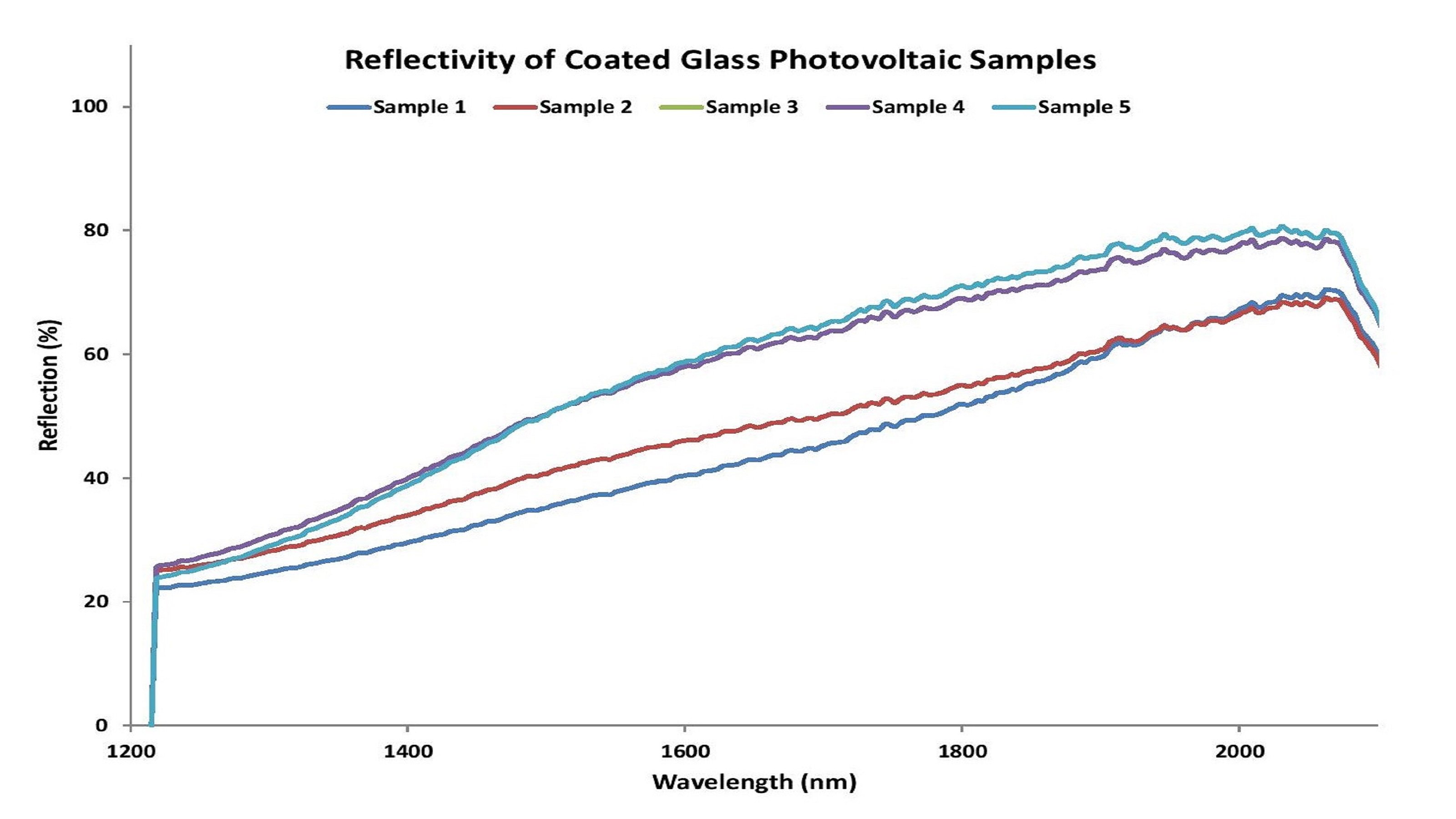Subscribe to Our Blog
Receive updates from our team as we share application notes, customer spotlights, educational tools, spectroscopy how-to’s, and more.

Compact, modular spectrometers are attractive tools for photovoltaic materials research and production. Applications include evaluation of solar cell materials and quality control in solar cell module production.
We evaluated NIR spectroscopy as a method to measure the reflection of materials used in photovoltaic panels (modules). A manufacturer of thin film photovoltaic panels requested NIR reflectivity analysis of several proprietary coated glass samples. Measurements were conducted from 1200-2100 nm under ambient lab lighting conditions.
Because the absorbance characteristics of photovoltaic panels are so critical to solar cell efficiency, determining the reflectivity at panel edges and elsewhere is a good indicator of the light loss at those areas. The use of anti-reflective coatings and glass dopants are among many materials manufacturers may evaluate to improve energy conversion efficiency.
Five coated glass samples were analyzed with an Ocean Optics NIR spectrometer that was customized with a 100 um entrance slit and optimized for the range from 1200-2100 nm. (A preconfigured NIRQuest+2.2, which covers 900-2200 nm, would be the spectrometer of choice today.) The sampling setup comprised a tungsten halogen light source, 400 µm reflection probe and an optical stage. A specular reflection standard was used as a reference. Spectrometer operating software completed the setup.
The glass samples were placed on the sample holder uncoated side down, to ensure the probe measured the reflection from the coating through the glass. The optical stage positioned the probe at 90° to measure specular reflectance.
Measurements were taken under overhead lighting conditions. The high-powered tungsten halogen light source provided continuous illumination from 360-2000 nm. The distance from the tip of the reflection probe to the surface of the sample was measured at ~7.0 cm for each sample, to simulate production conditions.
Ocean Optics NIRQuest+ spectrometers have an enhanced optical bench design for high-sensitivity performance, allowing for low limits of detection at NIR wavelengths from 900-2500. NIRQuest+ has great thermal stability and can be used in the lab or on the line, such as on a conveyor belt, as its higher sensitivity allows users to capture the necessary spectra over shorter integration times. Also, at longer wavelengths, as in the evaluation of solar panel materials, NIRQuest+ measures diffuse reflection at low noise levels, resulting in cleaner spectra at wavelengths where distinct spectral features can be difficult to capture.
The reflection spectra for the samples demonstrated that reflection values increased as a function of wavelength comparably across all five samples, peaking at about 2000 nm (Figure 1). Also, the gap between the least reflective and most reflective samples was relatively narrow at the lower and upper ranges of the wavelength range, with the greatest variation observed near 1700 nm. Spectra were captured without averaging or boxcar smoothing functions applied.

Figure 1. NIR specular reflection measurements reveal spectral differences in coated glass samples evaluated for use in photovoltaic panels.
Reflectance intensity of the coated samples ranged from ~25% at lower wavelengths to as much as 80% at higher wavelengths. These values are relative to the response of the specular reflectance standard, which has nearly “flat” reflectivity across all NIR wavelengths.
As developers of photovoltaic materials seek improvement in cell efficiency, the need for convenient analytical tools to evaluate glass coatings, dopants and other materials is great. Optical sensing systems such as NIR spectrometers can be configured for both research lab and process line applications.
NIR spectroscopy can be used to determine the specular reflectivity of coated glass samples relative to each other and to known reflectance standards. As a result, the solar light-capturing efficiency of the sample coatings can be inferred using Ocean Optics spectrometers and accessories.
Here’s a small sampling of recent open-access papers and citations about solar materials analysis, including increasingly popular perovskite solar cells:
Anaya, M., Correa-Baena, J.P., Lozano, G., Saliba, M., Anguita, P., Roose, B., Abate, A., Steiner, U., Grätzel, M., Calvo, M.E., Hagfeldt, A., and Míguez, H., “Optical analysis of CH3NH3SnxPb1-xI3 absorbers: a roadmap for perovskite-on-perovskite tandem solar cells,” Journal of Materials Chemistry A, 2016, 4, 11214-11221
Cacovich, S., Divitini, G., Ireland, C., Matteocci, F., DiCarlo, A., and Ducati, C., “Elemental Mapping of Perovskite Solar Cells Using Multivariate Analysis: an Insight of Degradation Processes,” ChemSusChem, Vol. 9, Issue 18, Sept. 22, 2016.
Karin, T., and Jain, A., “Visual Characterization of Anti-Reflective Coating on Solar Module Glass,” 2020 47th IEEE Photovoltaic Specialists Conference, added to IEEE Explore 05 January 2021 (citation only)
Karin, T., and Miller, D., “Nondestructive Characterization of Antireflective Coatings on PV Modules,” IEEE Journal of Photovoltaics, Volume 11, Issue: 3, May 2021 (citation only)
Liu, Y., Yangui, A., Kiligaridis, A., Moons, E., Gao, F., Ingañas, O., Scheblykin, I.G., and Zhang, F., In Situ Optical Studies on Morphology Formation in Organic Photovoltaic Blends, Small Methods, 13 September 2021.
Merdasa, A., Rehermann, C., Hirselandt, K., Li, J., Maus, O., Mathies, F., Unold, T., Dagar, J., Munir, R. and Unger, E., “Eye in the process: Formation of ‘triple cation’ perovskite thin films rationalized by in-situ optical monitoring,” Research Square preprint, Version 1, posted 04 November, 2020.
Zhang, Y., Wang, N., Wang, Y., Zhang, J., Liu, J. and Wang, L. All-polymer indoor photovoltaic modules, iScience, Volume 24, Issue 10, 22 October 2021.
High-sensitivity NIR spectrometers for applications within the 900-1650 nm, 900-2120 nm and 900-2450 nm wavelength ranges
Options available
Reflectance standards are available for diffuse or specular reflectance applications. To ensure best results, select a standard with reflectivity comparable to the sample to be measured.
Prices From $468.00

Receive updates from our team as we share application notes, customer spotlights, educational tools, spectroscopy how-to’s, and more.